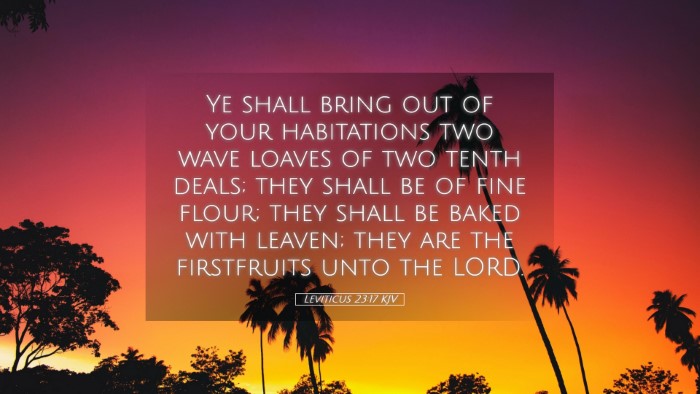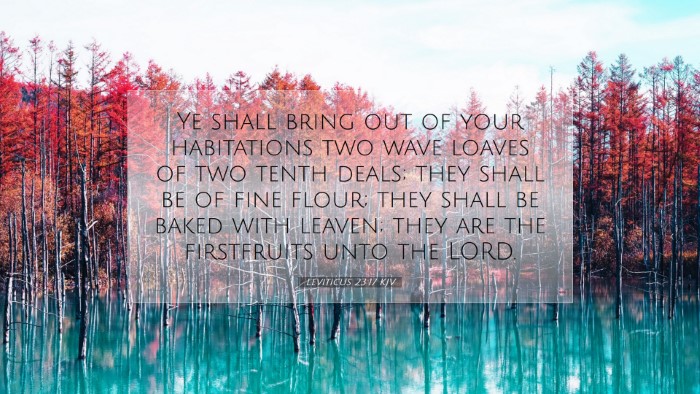Commentary on Leviticus 23:17
Verse: "You shall bring from your dwellings two wave loaves of two-tenths of an ephah. They shall be of fine flour; they shall be baked with leaven. They are the firstfruits to the LORD."
Introduction
The verse in Leviticus 23:17 is part of the broader context of the Jewish festival calendar, specifically concerning the Feast of Weeks, also known as Pentecost. This festival, occurring fifty days after Passover, celebrates the harvest and commemorates the giving of the Law. The command to present two wave loaves (or loaves of bread) as part of this celebration carries deep theological and practical significance that draws insights from various public domain commentaries.
Context and Significance
According to Matthew Henry, understanding the context of the Feast of Weeks is paramount. The festival symbolically represents the acknowledgment of God as the giver of food and sustenance—an important aspect of the Israelite agricultural calendar. The firstfruits presented, in this case as wave loaves, signify the Israelites' gratitude toward God for His provisions.
Harvest Celebrations
In connection with the agricultural aspects, Albert Barnes refers to the practice of bringing the firstfruits, which were a critical element in acknowledging God's role in the harvest. The presentation of the loaves at the temple emphasizes community and shared celebration, grounding individual gratitude in corporate worship. The act of waving indicates reverence and recognition of God's sovereignty over the bounty of the earth.
The Meaning of the Wave Loaves
The wave loaves are described as being made from fine flour and baked with leaven. Adam Clarke highlights the significance of using leaven in these loaves, which contrasts with the unleavened bread associated with Passover. Leaven often symbolizes sin or corruption in Biblical texts; however, it is also a representation of growth and the Spirit's transformative power within believers.
Firstfruits and their Importance
- Symbol of Devotion: The two loaves, representing firstfruits, signify devotion to God and the acknowledgment of His provisions (Henry).
- Unity of Believers: The two loaves can also symbolize the unity of both Gentiles and Jews in Christ (Barnes).
- Transformation: The inclusion of leaven signifies the transformative work of the Spirit, suggesting that while sin may exist, God’s grace abounds (Clarke).
Theological Implications
Moreover, the wave loaves serve as a foreshadowing of New Testament teachings regarding the nature of Christ and His church. According to Henry, the loaves can be interpreted as types of Christ Himself—the perfect loaf without sin, yet the leaven can represent His followers who are imperfect but are being transformed through His grace.
Worship and Community
As mentioned by Barnes, the communal aspect of this rite is significant. The act of presenting the loaves is not merely a personal act of thankfulness but a collective acknowledgment of God’s goodness within the community of Israel. This communal worship reinforces the idea that spirituality is not simply a personal affair but one that resonates within a larger faith community.
Practical Applications
The implications of Leviticus 23:17 extend beyond the ritual of ancient Israel; it calls for contemporary application among believers.
- Gratitude in Worship: Like the Israelites, modern believers are encouraged to bring their firstfruits—the best of their time, resources, and talents—in worship (Henry).
- Inclusion of All Believers: This verse invites reflection on how to cultivate a sense of unity among diverse believers within the church (Barnes).
- Embrace of Transformation: The presence of leaven encourages believers to embrace their growth journey, allowing the Holy Spirit to lead them toward holiness (Clarke).
Conclusion
Leviticus 23:17 serves as a rich theological tapestry that weaves together themes of gratitude, communal worship, growth, and spiritual transformation. By examining insights from Matthew Henry, Albert Barnes, and Adam Clarke, pastors, students, theologians, and Bible scholars can draw meaningful applications that resonate with their faith and practice. The call to present our offerings as wave loaves challenges believers to acknowledge God’s provision actively, to embrace their imperfections, and to partake in the communal journey of faith.


